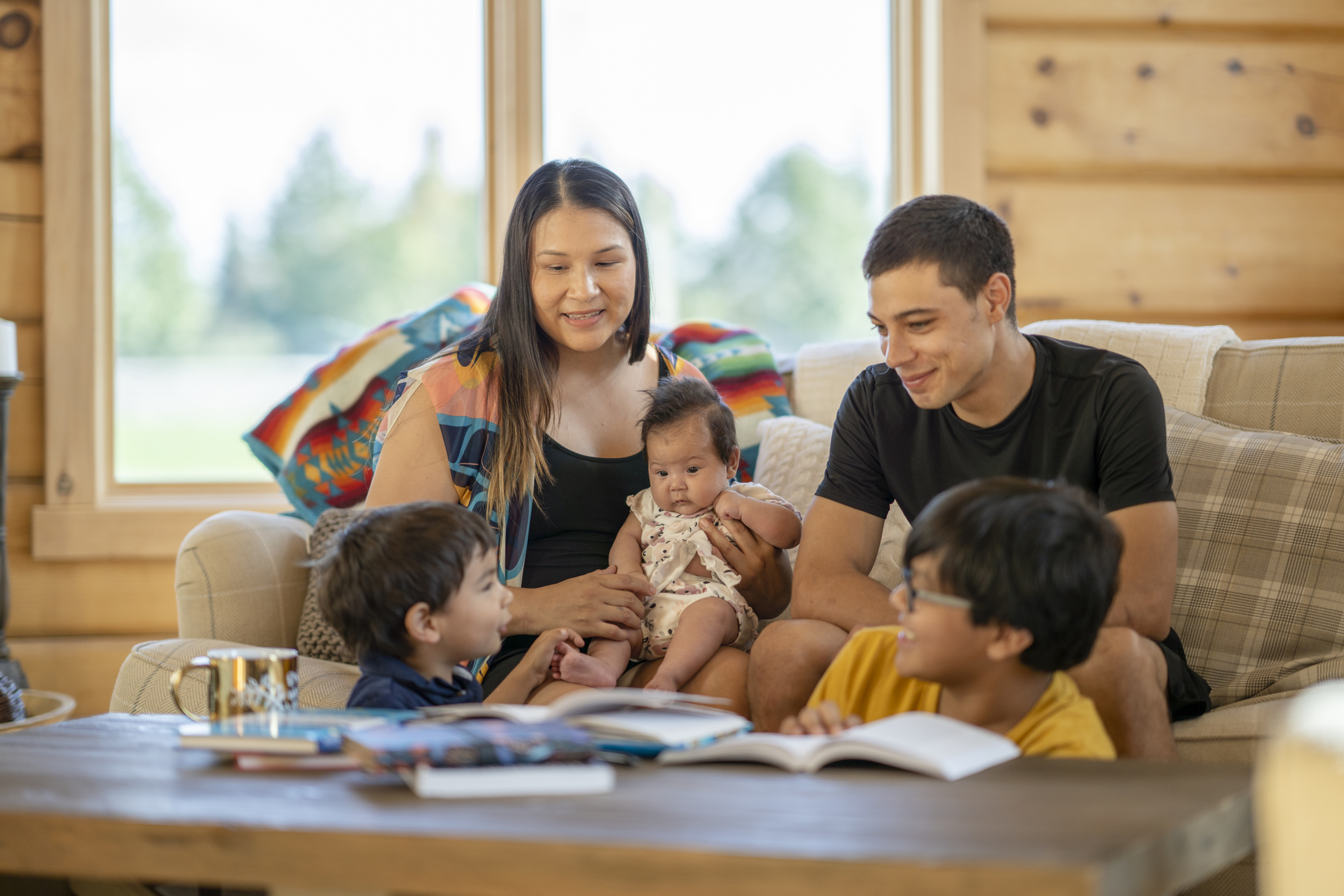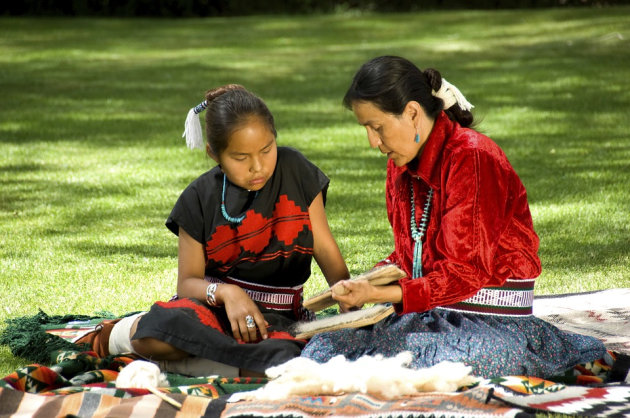
The Enduring Weave: Traditional Navajo Parenting and Child-Rearing
At the heart of traditional Navajo (Diné) parenting and child-rearing lies a profound philosophy rooted in Hózhó – the pursuit of harmony, balance, and beauty in all aspects of life – and K’é – the intricate web of kinship, relationships, and reciprocal responsibilities that bind the community. This is not merely a set of rules, but a holistic worldview, a continuous journey of learning and becoming, meticulously woven into the fabric of daily existence from the moment a child is conceived. For the Diné, children are sacred gifts, embodying the future and carrying the ancestral spirit, and their upbringing is a collective endeavor, guided by centuries of wisdom.
From infancy, the Diné child is immersed in an environment of gentle, yet deliberate, nurturing. The cradleboard (awééts’áál) stands as a powerful symbol of this early care. Far from being a restrictive device, the cradleboard is a carefully crafted tool designed to provide security, comfort, and a unique form of early sensory regulation. Swaddled snugly, with their arms tucked in and legs straight, infants in a cradleboard often exhibit a calm demeanor, allowing them to observe their surroundings with focused attention. Elders teach that the cradleboard helps develop good posture, strengthens the back, and fosters a sense of discipline and concentration. It keeps the baby safe while the mother works, whether she is weaving, cooking, or herding sheep, allowing for constant proximity and interaction. This constant physical closeness, often through extended breastfeeding, fosters an unbreakable bond between mother and child, grounding the child in the physical and emotional warmth of their primary caregiver.
Learning in a traditional Navajo household is primarily observational and experiential, a process known as "learning by watching, listening, and doing" (nitsáhákees, nahat’á, iiná, siihasin – thinking, planning, living, assuring). Children are not seen as empty vessels to be filled, but as capable individuals whose innate curiosity and drive to contribute are to be gently guided. There is minimal direct instruction or forceful commands. Instead, children are invited to participate in daily activities alongside adults from a very young age. A toddler might be given a small broom to sweep alongside an elder, or a young girl might sit by her grandmother’s loom, observing the intricate patterns and movements, eventually being allowed to try a few strands herself. This immersive approach cultivates independence, self-reliance, and a deep understanding of their role within the family unit and the wider community.
The extended family, or K’é, is the bedrock of Diné child-rearing. Grandparents, aunts, uncles, and cousins all play pivotal roles in a child’s development, offering multiple layers of support, guidance, and cultural transmission. The clan system, with its four foundational clans (maternal, paternal, maternal grandfather’s, paternal grandfather’s), dictates respectful relationships and responsibilities. A child learns early on not just who their immediate family is, but also their intricate connections to hundreds of relatives, fostering a strong sense of belonging and collective identity. Grandparents, in particular, are revered as reservoirs of wisdom and cultural knowledge. They are often the primary storytellers, passing down oral histories, creation myths, moral lessons, and practical knowledge through captivating narratives. These stories, especially those told during the long winter nights, are not mere entertainment; they are foundational texts that teach children about their origins, their relationship to the land, their values, and the consequences of their actions. Coyote stories, for instance, often serve as cautionary tales, illustrating the importance of humility, respect, and wisdom.
Discipline in traditional Navajo parenting is rarely punitive or shaming. It emphasizes positive reinforcement, redirection, and the natural consequences of actions. Instead of harsh punishments, parents and elders often use storytelling, gentle reminders, or the silent disapproval of the community to guide a child back to the path of Hózhó. Children are taught to respect their elders, their peers, and all living things. They learn that their actions have ripple effects, impacting not only themselves but also their family and the balance of the world around them. This approach fosters intrinsic motivation and a strong internal moral compass, rather than obedience driven by fear.

As children grow, their responsibilities within the family expand. Boys might learn to herd sheep, tend to livestock, and perform agricultural tasks alongside their fathers and uncles, developing a deep understanding of animal husbandry and land management. Girls learn to weave, cook, gather traditional foods, and care for younger siblings from their mothers and aunts, mastering the skills necessary to sustain a household and nurture a family. These chores are not seen as burdens but as essential contributions to the collective well-being, instilling a strong work ethic and a sense of pride in their contributions. Through these daily activities, children also learn the profound connection between their actions and the natural world, understanding the cycles of seasons, the behavior of animals, and the medicinal properties of plants. The land, Dinetah, is not just a place but a living entity, a sacred relative that provides sustenance and spiritual guidance. Children are taught to walk in beauty, to respect the earth, and to understand their place within its delicate balance.
A significant milestone for young Navajo women is the Kinaaldá, a four-day puberty ceremony that celebrates a girl’s transition into womanhood. This ancient rite mirrors the first Kinaaldá performed by Changing Woman (Asdzáá Nádleehé), a revered deity in Diné cosmology who embodies growth, fertility, and the power to create and sustain life. During the Kinaaldá, the girl performs tasks that test her endurance, such as running long distances at dawn and grinding corn for hours. Her body is molded by an elder woman, symbolizing the shaping of her future self, and she receives blessings and prayers. This ceremony imbues her with the strength, resilience, and wisdom of Changing Woman, preparing her for the responsibilities of adulthood, motherhood, and her role in perpetuating the Diné way of life. For boys, while there isn’t a singular, universally practiced ceremony akin to the Kinaaldá, their journey into manhood is marked by increasing responsibilities, participation in community ceremonies, and mentorship from male elders who teach them hunting, ceremonial knowledge, and leadership skills.
The Navajo language, Diné Bizaad, is an inseparable component of traditional parenting. It is not just a means of communication but a vessel for cultural knowledge, philosophical concepts, and spiritual understanding. Speaking Diné connects children directly to their ancestors, their land, and the intricate worldview embedded within the language itself. The nuances of Diné Bizaad allow for the expression of complex concepts like Hózhó and K’é in ways that are difficult to translate directly into other languages. Preserving and transmitting the language is thus seen as a critical act of cultural survival and identity formation.
In essence, traditional Navajo parenting is an art form, a continuous process of sculpting individuals who are deeply connected to their family, their community, their land, and their spiritual heritage. It fosters individuals who are resilient, responsible, independent, respectful, and committed to walking in beauty – Hózhó náhásdliį́. While modern influences and historical challenges like boarding schools and cultural assimilation have impacted these practices, many Diné families today actively work to revitalize and integrate these timeless principles, ensuring that the enduring weave of traditional Navajo child-rearing continues to shape the future generations of the Long Walk People.



